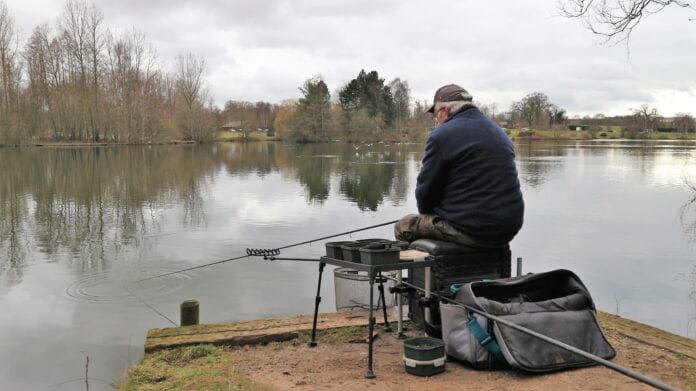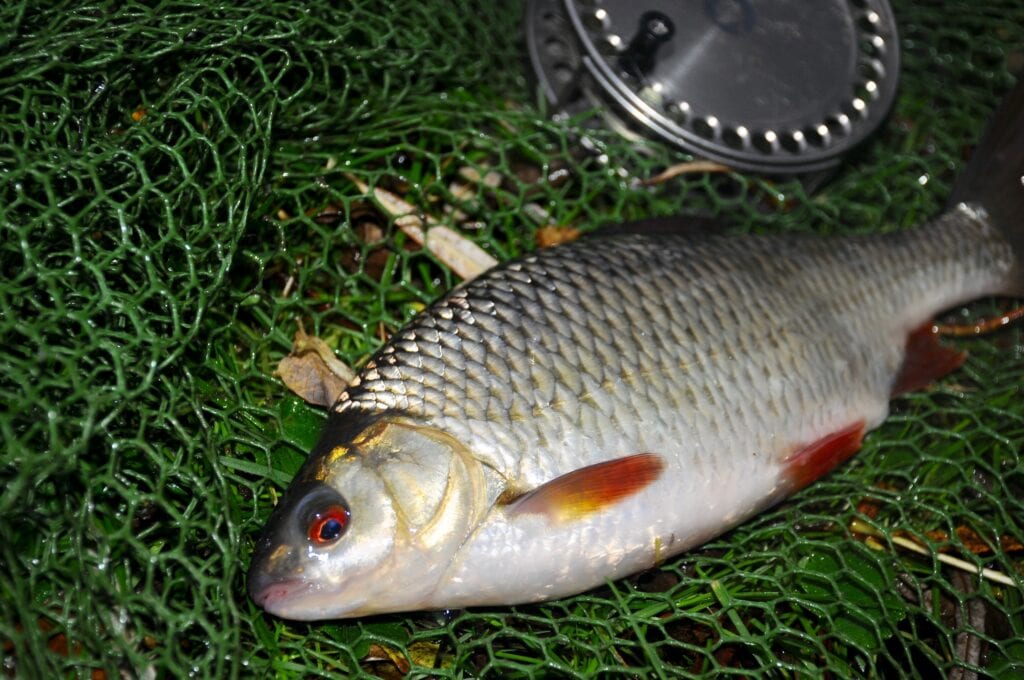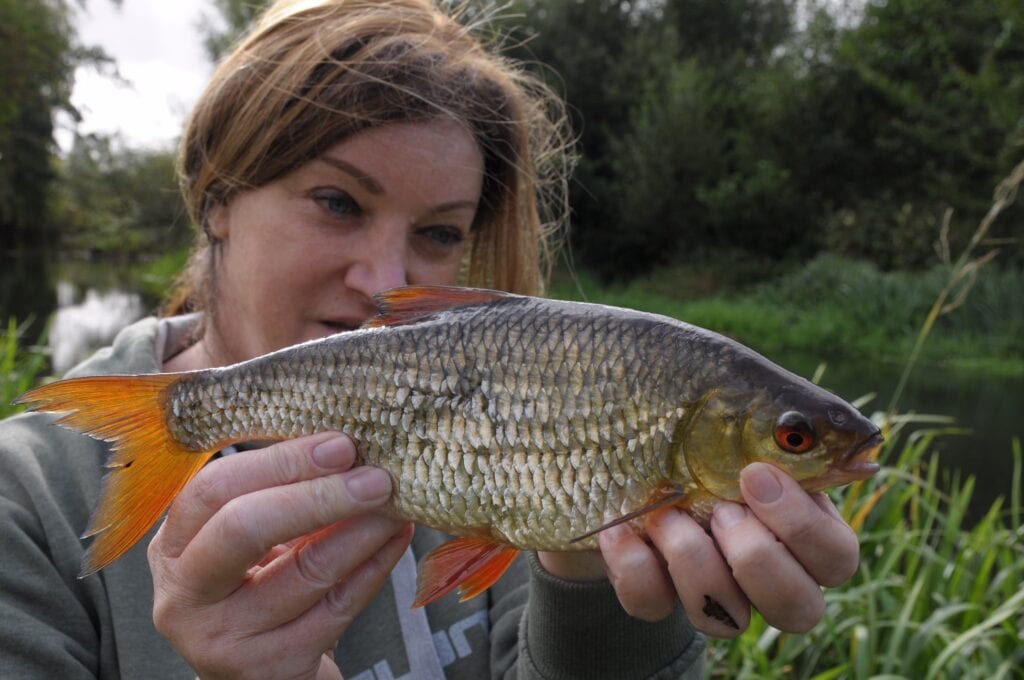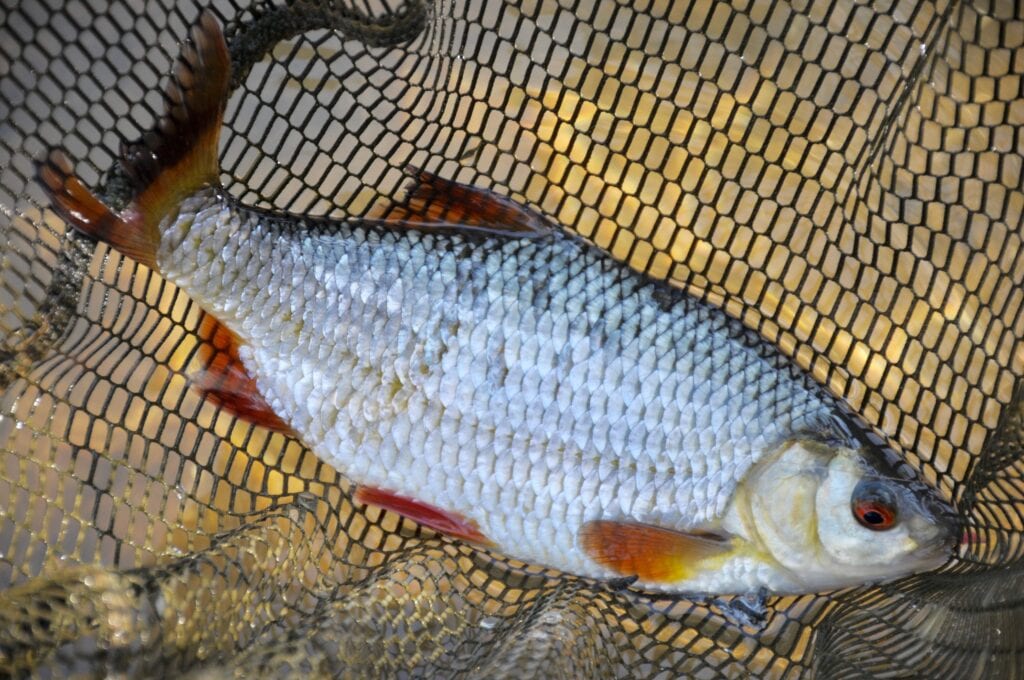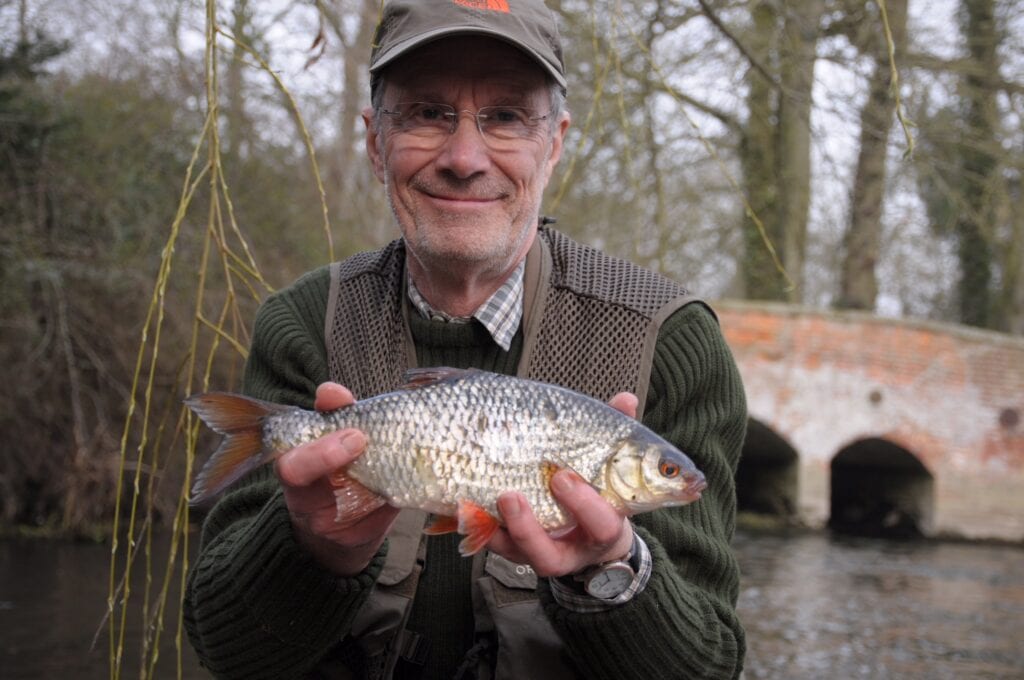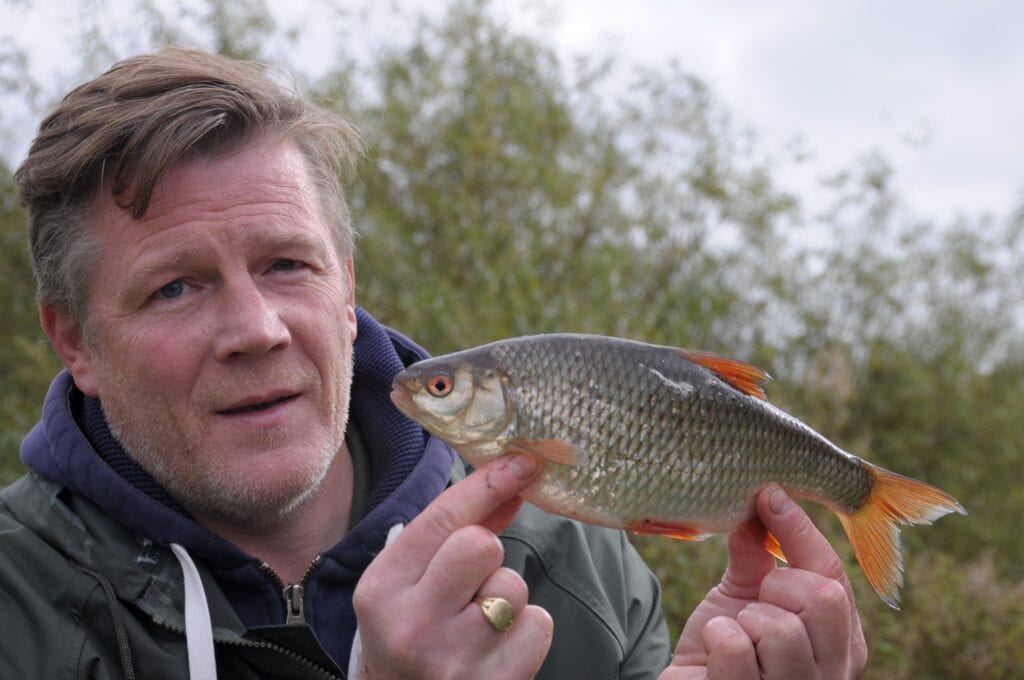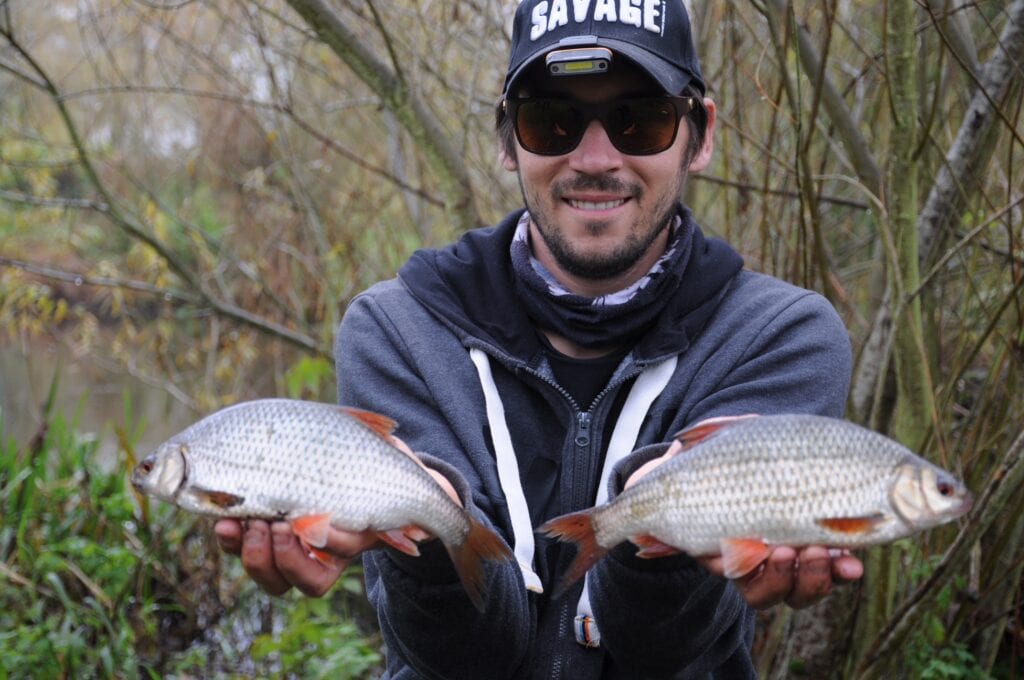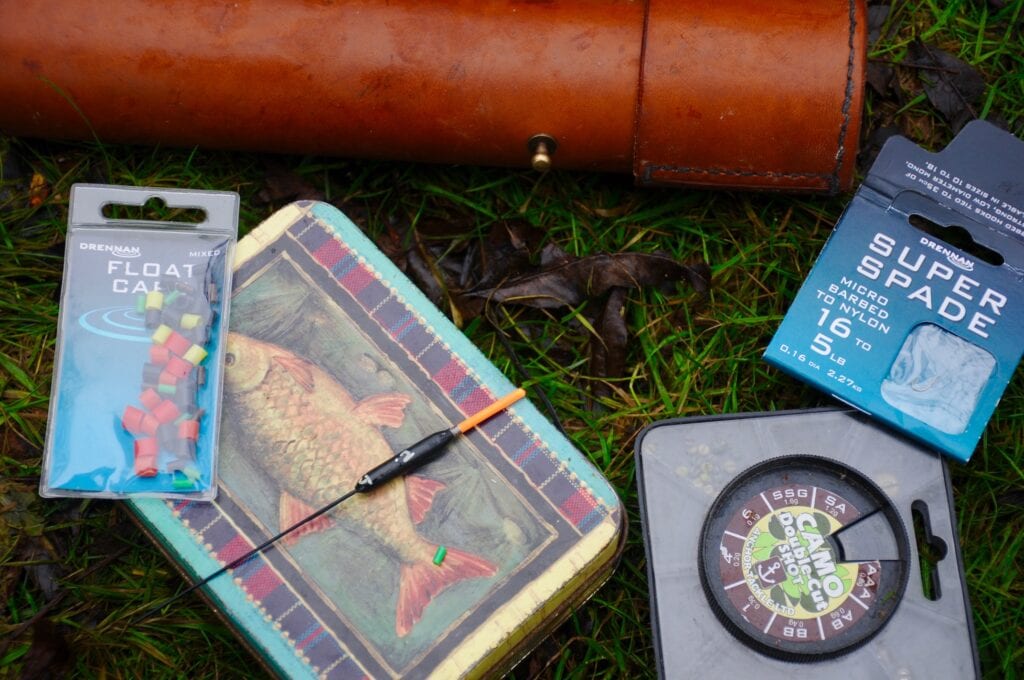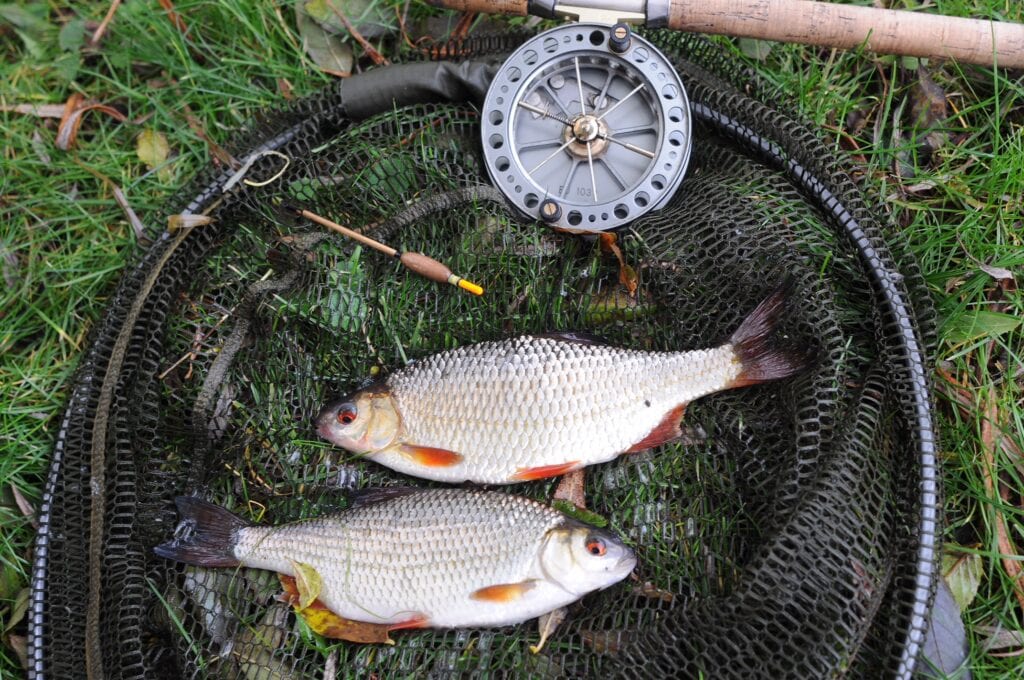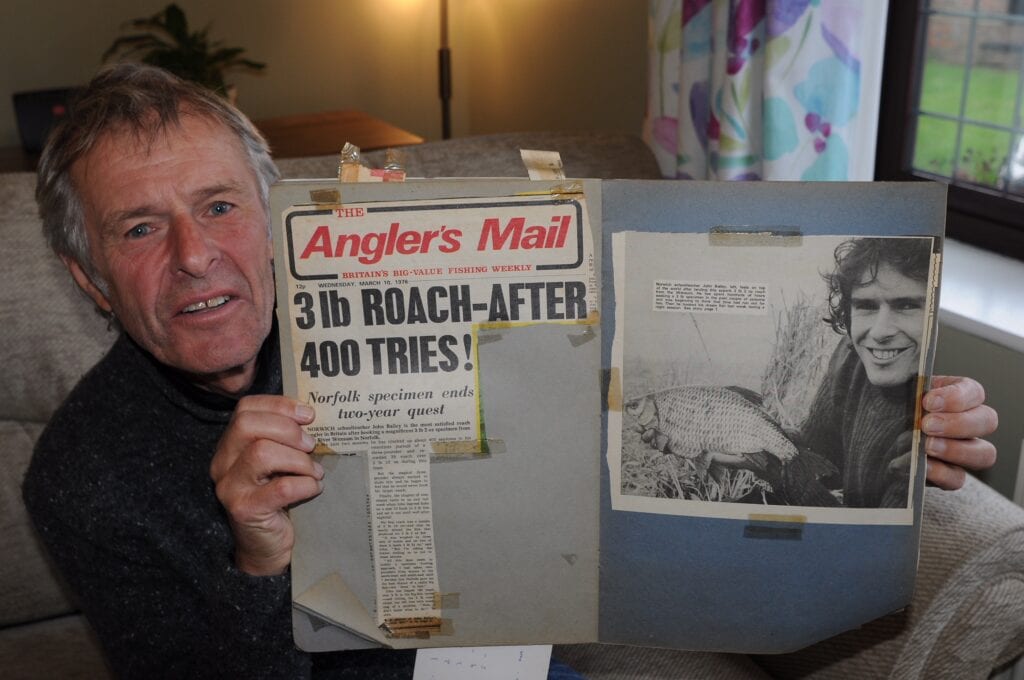Dave Coster – Big Winter Roach
OFF PEAK
At one time I thought tracking down big roach required privileged access to exclusive river beats, or joining long waiting lists to be able to fish top club waters. But with a bit of hard graft, I’ve realised it’s possible to catch specimen-sized red fins from some surprisingly accessible, and often quite busy places. This is a holiday complex, open to everyone on a day ticket. It can be heaving with people in summer, but is normally much quieter when cold weather sets in during the depths of winter. For much of the year you could be wasting your time trying to locate any sizeable roach from this big lake, especially during the warmer months when bream, perch and big carp take over the place. But once cold water pushes the carp and skimmers into hibernation, surprisingly big roach come out to play. They are ultra-shy and it would be easy to miss them completely if you didn’t know they were there. It took me time to fathom out how to catch these fish, which are moody to say the least.
FEEDER EFFECTS
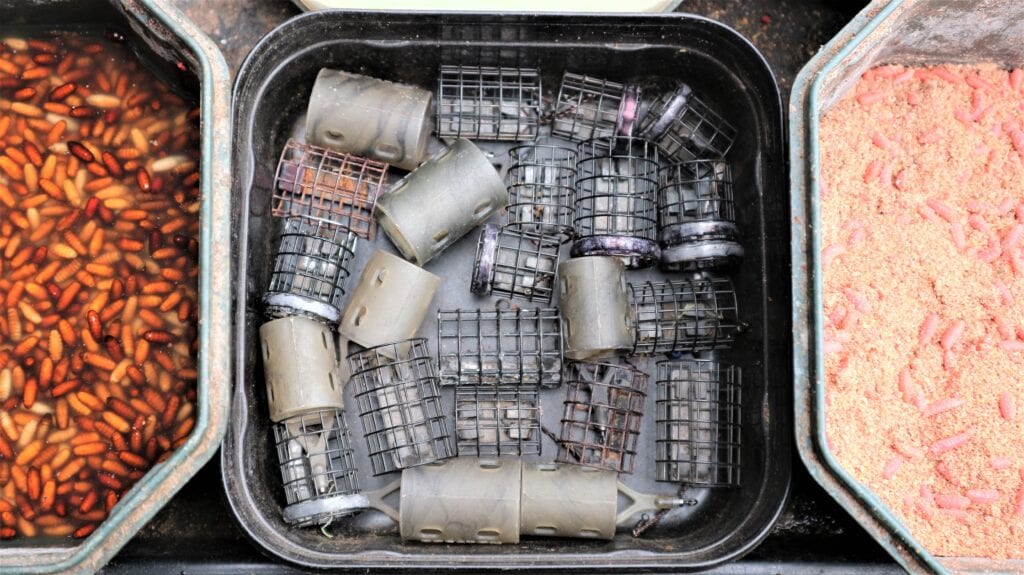

I mainly use cage feeders for quality roach when the going is tough. They are less obtrusive than plastic groundbait designs, releasing their loadings faster and in a more active manner. This is important when trying to stir a response in freezing cold conditions. Fish are often attracted to the shower of particles as a cage feeder touches down. Apart from expecting bites as the tackle settles, I often twitch the rig in a bit after a minute or so. This agitates the newly released grub, leaving my hook bait right over everything, encouraging savage takes. I prefer compact feeders, which I cast regularly to stir a response without over-feeding. I combine these with dark, non-fish groundbaits, laced with hemp and casters. If nothing is happening it can help to mix some chopped worms into the groundbait. This might pull in small perch initially, but roach often follow them. Plastic open-end feeders are reserved for very deep water, helping concentrate the feed into a tighter grouping.
MINT FISH
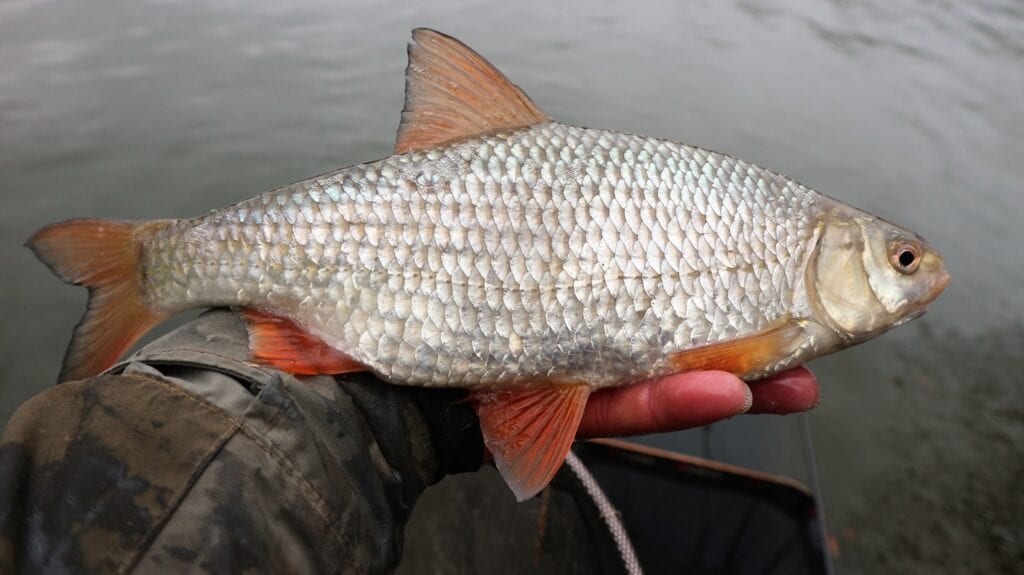

It never ceases to amaze me how pristine and fighting fit most of the big roach I catch at this time of the year are. When you consider how busy places like this day ticket venue get during the warmer months, you would expect many fish to show signs of being battle-scarred. Odd ones do, but generally I don’t think the majority I catch have ever seen a landing net before. This is down to these wily old ‘uns being extremely cunning and shy, otherwise they probably wouldn’t have survived to this stage. It takes lots of watercraft, clever feeding, and refined tackle to unlock big roach like this. This applies to both feeder and float tactics, requiring hooks and lines to be scaled down to smaller sizes and thinner gauges. It also helps to have different feed lines. This is an old match fishing trick, resting and feeding areas to make fish more confident. For me, rotating between float and feeder tackle works well. Switching about regularly results in bonus spurts of action with both methods.
LINKING UP
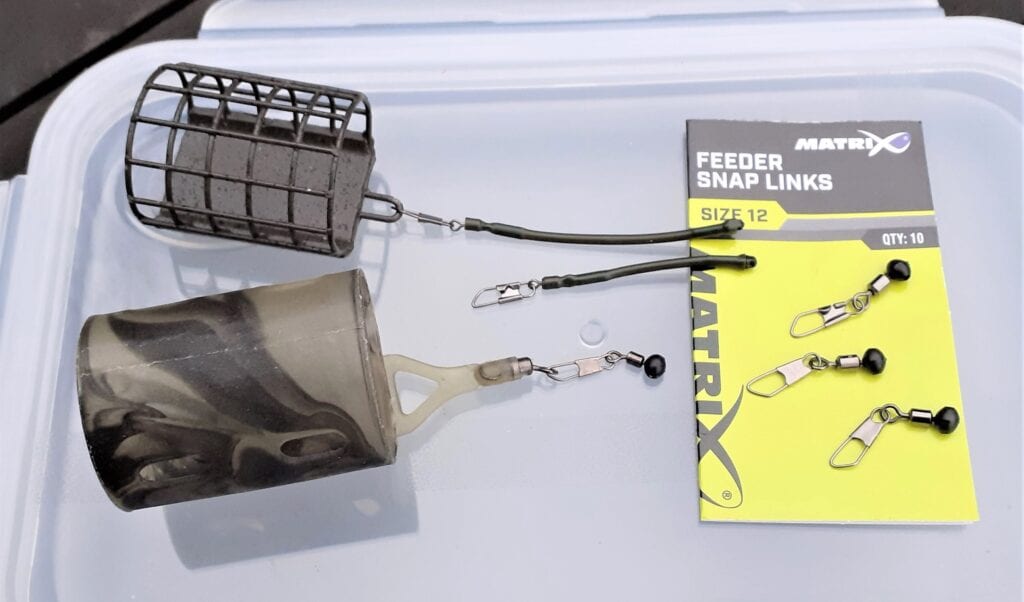

I highly rate the new breed of clip-on feeder links and snap links. Feeder links come in different lengths, and are great for creating safe, free-running paternoster rigs. The big advantage being they allow quick changes of feeders, or a complete switch to a leger weight. The latter feature is particularly important in winter, where switching to a bomb for a while helps to rest the swim and prevent over-feeding it, a tactic that often brings bites back when they are threatening to dry up. Feeder links work best with swimfeeders that don’t have a proper link, just a swivel or wire loop they can be clipped to. I don’t like using them combined with an existing long link that’s already part of a feeder, because it gets messy on the cast and can cause tangles. More compact snap links with free-running beads are better for clipping to feeder designs with long fixed links, also allowing quick changes and switching to leger weights. Keeping rigs versatile and simple makes good sense to me.
COLD CUISINE
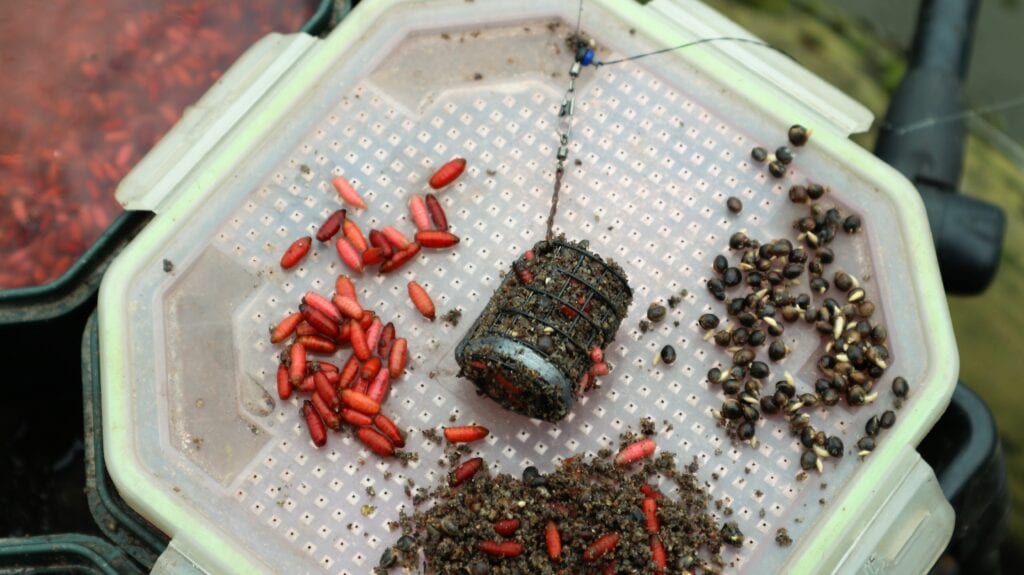

To spark big winter roach into feeding mode the groundbait and free offerings being used are important. My favourite cold water groundbait is equal parts of Sensas Noir, Sensas Black Lake, and brown crumb. This creates an active groundbait, which fizzes off attractive oils. I pre-mix this, whisking and riddling to achieve a light, fluffy consistency. On the bank I stir in a fraction more water if I’m feeder fishing to freshen things up, while with the pole even more moisture is usually required to get a better binding consistency. For both pole and feeder, I mix tinned hemp and fresh casters into the proceedings. I like to use tinned hemp because it’s very oily and smells even better than anything I can prepare at home. Tinned hemp is more convenient too, plus it’s extremely active in the way it fizzes off lots of oil, which can only help matters. Another good tip is to use casters that have been turned from red maggots. The resulting shells have an attractive extra glow about them.
POLE PRECISION
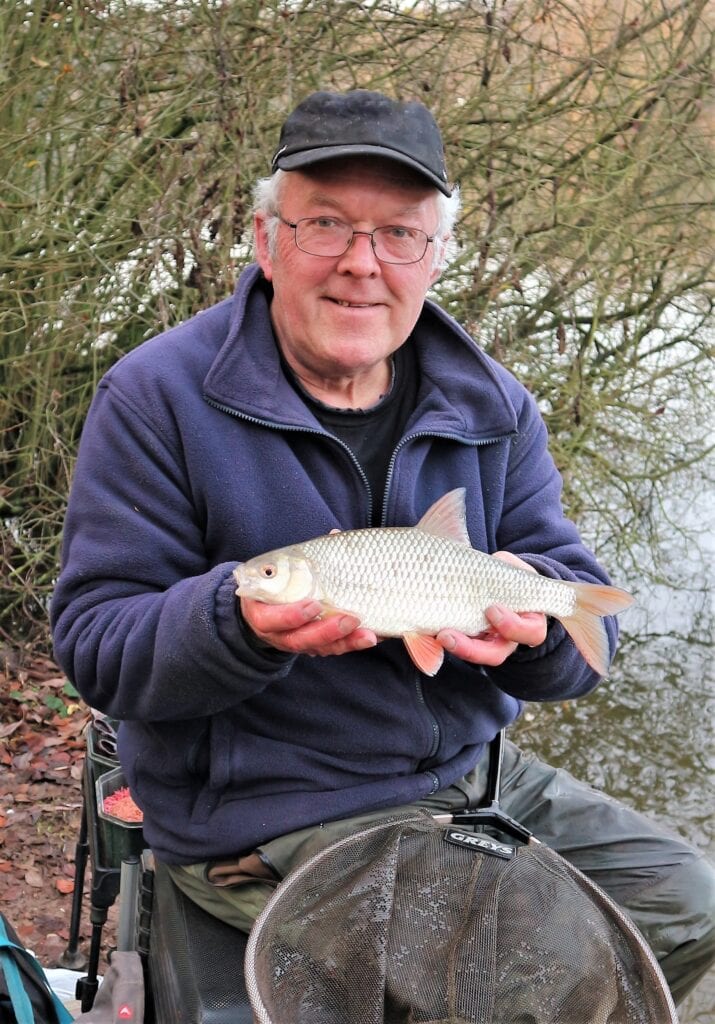

I catch a lot of big winter roach on the long pole, finding the inch-perfect presentation this method offers hard to beat. The pole allows me to fish much finer, using super-light tackle – a lot more delicate than I would be comfortable with on running line rigs. I’m talking about fine wire 18 or 20 hooks, combined with 0.08-0.10mm super-thin rig lines. Feeding with the pole is spot-on too, cupping in groundbait, and dinking casters or hemp over the top of a sensitive float with a light-actioned catapult. I prefer dark, crispy casters that are just about sinkers, because these agitate extra interest. If I find some of my casters are floaters, I take the air out with a pellet pump, much the same way as when making expander pellets sink. Another way is to soak any floating shells in water overnight. If they are not too far gone, most will have sunk by morning. Slow-sinking casters pull bonus bites, wafting up off the bottom easily when roach like this one are grazing over them.
MICRO MAGIC
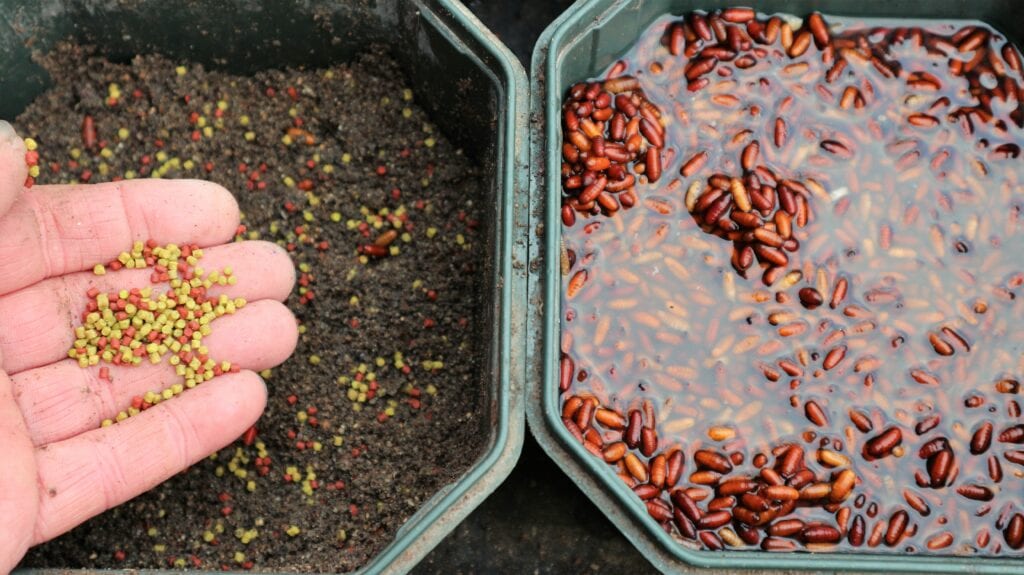

If I can get away with it, I don’t use fishmeal when targeting big winter roach. However, there are venues where this species has become so used to feeding on pellets and other related products, a hint of what they have become so reliant on is sometimes required. If this is the case, I add a few micro pellets to my groundbait. A mix of red krill and sweet F1 yellow works well for me, also adding attractive flecks of colour to darker mixes, without making them too pungent. I’m always wary with fishmeal products in cold water, after learning the hard way how over-strong ones can feed off silver fish very quickly. A good example was bream fishing in winter, where my results improved dramatically when I began diluting pellet-based groundbaits with sweet mixes. I discovered the fish stayed in my swim much longer, whereas previously a quick burst of action was all I got. I think the same applies to roach, which can be interested in fishmeal products but quickly over-fed by them.
NEAT CUPPING
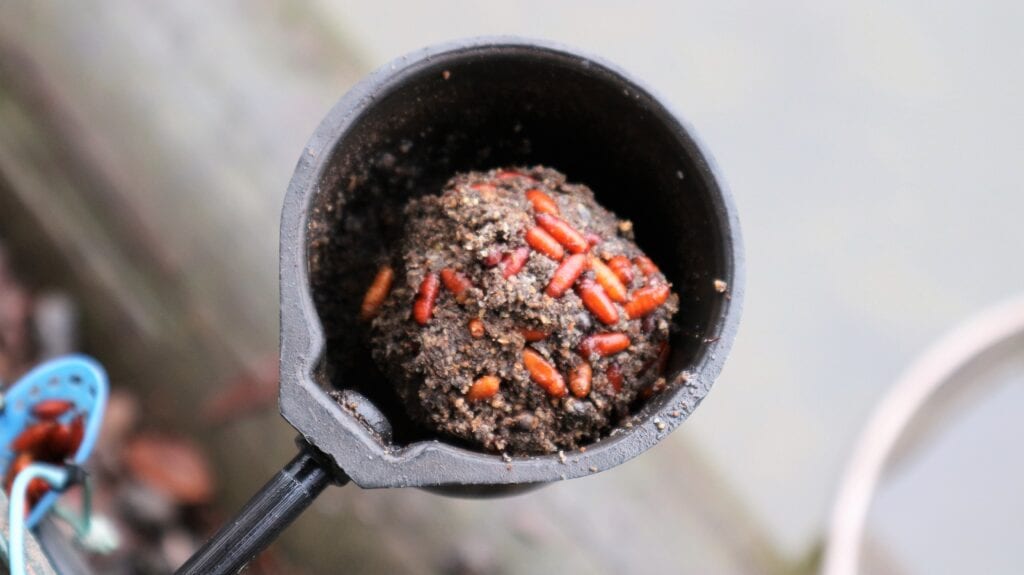

I start pole sessions with a few hard balls of groundbait laced with casters. I don’t put micro pellets or chopped worm in straight away, while with hemp I often cup this in neat over the top of a bed of groundbait. A good helping of cooked seeds is unlikely to feed off any roach in the swim. I think of hemp as more of an attractant in cold water, plus if the fish aren’t actually eating it, tinned stuff acts like a bite alarm when fish are grazing over it. If the surface is calm, I know when roach have switched on over my feed because as they stir up the bottom the hemp starts to fizz off oils again, like it does when its fed initially. This is a great indicator if you are fishing a two-pronged attack, such as the feeder at range and float tackle closer in. While watching a quivertip you soon notice tiny bubbles of oil pin-pricking the surface when a shoal of roach has moved over your inside feed line. Hemp still fizzes when it’s disturbed, even after has been laying on the bottom for several hours.
SWITCHING ON
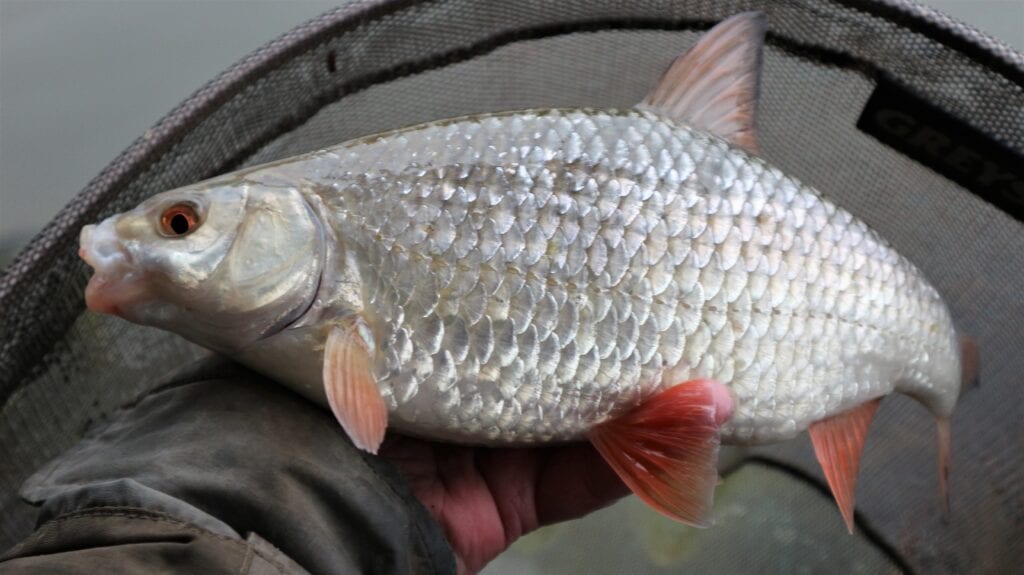

The last hour of winter daylight is widely recognised as a prime feeding time for big roach, but there are rare sessions when the fish become active earlier, or even feed all day long. In my experience there’s no rhyme or reason for this, but obviously any bonus action is always well received. I’ve enjoyed quite a few outings where I’ve also managed to pick off cracking red fins by switching between the feeder and pole. This dual approach often finds fish responding first on feeder tackle – out in open water – and then turning up later, closer in on the pole. Best places to locate the shoals at distance are normally a fair way out in deep water. I don’t think you need to worry greatly about finding any slight variations in depth, because keeping a small feeder going in regularly tends to draw fish in. But obvious features like gravel bars and islands are worth exploring. Best area for the pole tends to be at the bottom of the nearside shelf, providing there’s good depth there.
LAST KNOCKINGS
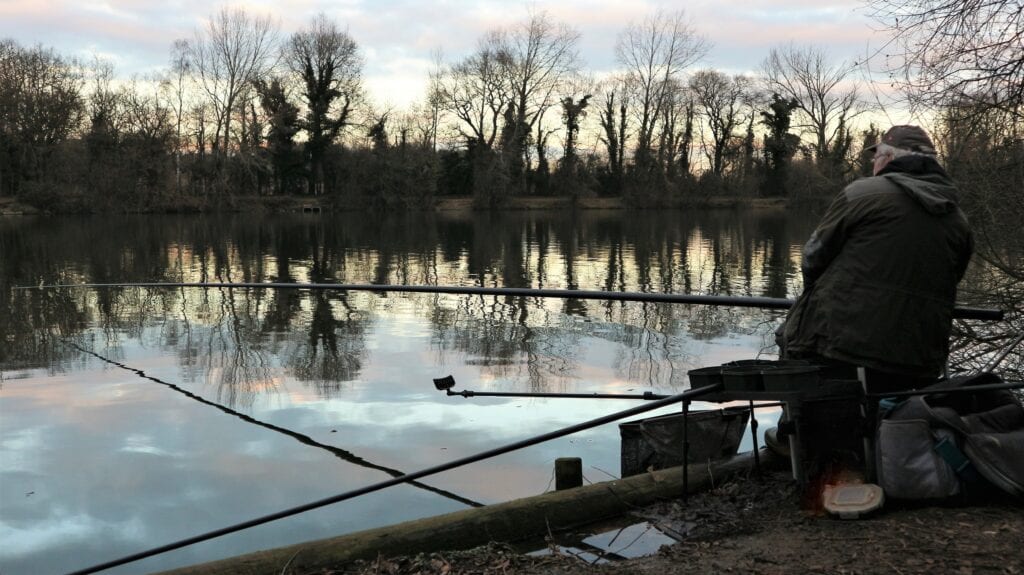

Sport is unlikely to be hectic at this time of the year, especially when most other species have switched off. Even the roach can be lethargic or go missing, but they usually turn up as the light begins to fade. I normally fish until I can’t see my float tip any more. That magical final period often turns a session around, sometimes quite dramatically. When I’m pole fishing, I know when the fish have arrived and started feeding because, as I’ve mentioned previously, I can see clouds of tiny bubbles over my feed. The rich groundbait and hemp oils start to fizz to the surface as everything gets disturbed, normally by big roach rooting on the bottom. At this stage it helps to lift and lower my pole rig to induce bites, working in tandem with the dark casters I’ve been feeding, which waft around as fish swim over and agitate them. If I haven’t been getting bites up until this stage, I won’t have added any more groundbait after the first dose, only lightly loose feeding over the top.
SHALLOW SECRETS
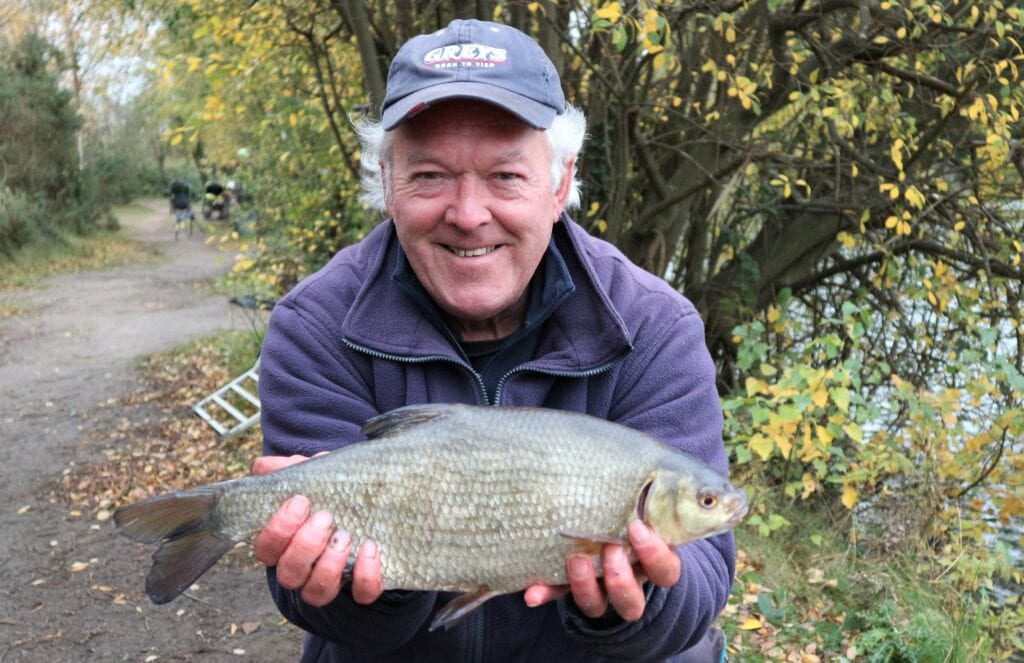

Although I expect the best action to occur as the light fades, I keep working for bites during the whole session. Yes, there will be many days, especially those bright, frosty and sunny ones, when roach refuse to feed until that magical final hour. But there will be times when it’s possible to stir the fish into having a go. After feeding with groundbait when pole fishing, I keep a constant trickle of casters going in my swim. The main lakes at Woodland Waters, where I do a lot of my winter roach fishing, are deep, and need something like this to stir a response. I don’t just fish on the deck either. I have a shallow rig set up, and it’s amazing how many times this finds big roach. With good depths of water to play with, roach aren’t always going to be stacked up on the bottom. Even when it’s cold they will compete up in the water for regular loose feed. This big hybrid did exactly that, giving me a few hairy moments. The thought of a three-pound roach crossed my mind, for just a second or two!
WINTER WONDERS
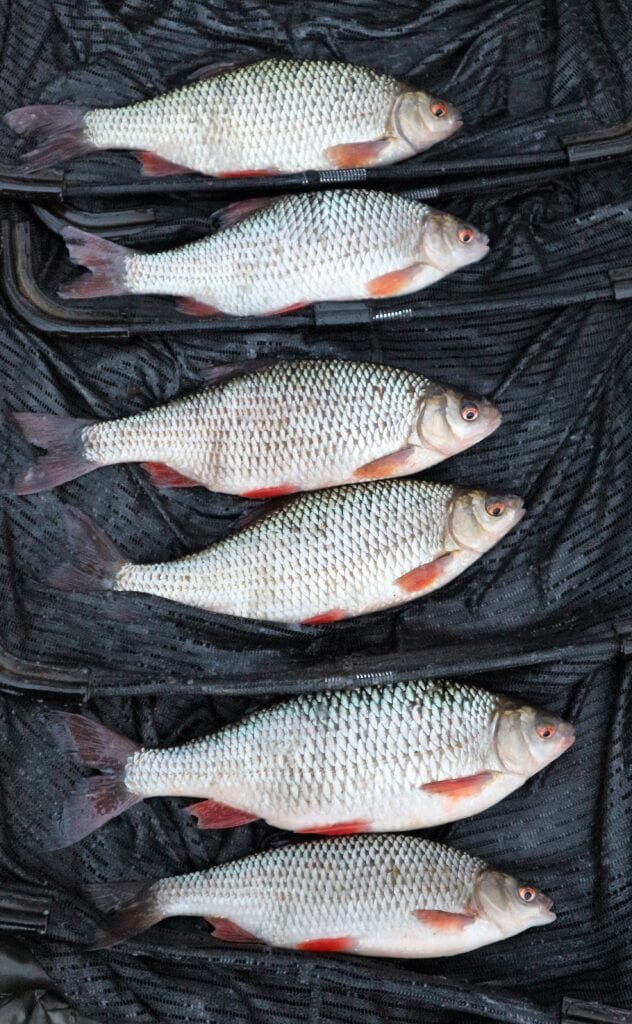

Cold weather angling can be slow going, but equally, there are those golden days when it all happens. For some reason, the roach switch onto the feed and you can bag up big time. It’s impossible to fathom what wakes the fish up, although if you’re not out there in the first place, you will never know! A lot of anglers pack up for the winter, something I can never understand. Many of my most memorable catches have come at this time of the year, uncovering fish like these, which completely disappear in the warmer months. They must lurk in the background, muscled out by other species like carp, tench and bream. But once those fish shut up shop, the big roach come out to play. These magnificent beauties turned up as part of a haul that would be deemed respectable on prime roach rivers like the Hampshire Avon or Dorset Stour, both of which I’ve fished. But who would have thought a catch like this could come from a holiday complex, just 10 minutes down the road from where I live! Chalets, caravans, bar, restaurant, several lakes, and top roach fishing, what a mix!


John Bailey – Big Roach
As many of you are getting to know, I am obsessed with better roach, but it was Dave C’s idea to do this week’s Our Way With… on them, rather than mine. So don’t hold me guilty of pursuing my passion. I’ve really struggled with this one. As ever, DC is so fantastically detailed in his approach, it is easy for me to hold my hands up and say I can never be this precise, this good. Yet, I have caught hundreds of big roach, seen thousands more caught, and above all spoken with and fished with hundreds of anglers who have all been roach maestros in their own ways. I think this is the key: there are so many ways to catch big roach – fish of a pound-plus – that it is hard to settle on any defining rules. What DC has done so brilliantly is to describe how to attack stillwater roach his way, but we must remember what a diverse subject this is. My first big roach came in 1962 from a Stockport mill dam. It went 1.14.12… ie, an ounce and few drams under the two. That was a staggering 59 years ago, and I have come to think I might be best trawling through my memory bank, highlighting scenarios that might throw light on this amazing species.
TOO RESTLESS FOR STILLWATERS
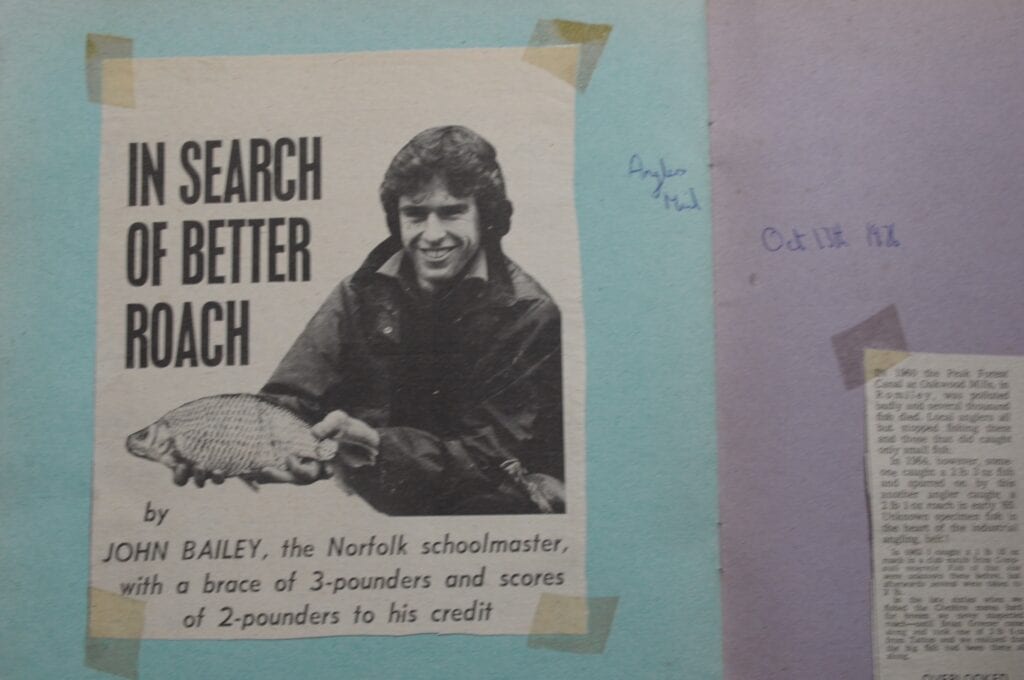

Stillwaters first. I have never gelled with them as roach venues. I’m probably too restless, and too disorganised. By that I mean I couldn’t see myself on a box for eight to ten hours… in fact, I don’t even own one any more. And when I read the intricacies of DC’s approach I just know I could never muster the discipline to fish as he does. Stills, too, nearly always hold too many small roach for my liking. I find it hard to wade through numbers of six-inchers, waiting for the big girls to arrive. And, also, I’ve seen too many stillwater hybrids to be really confident I am catching the real thing. Very many big “roach” I see reported from pits I have qualms about. Many years ago, I fished Tom’s Lake in the Wensum valley, and the 2lb-plus fish were all a bit different from each other. Some looked a bit “ruddy” or a bit “roachy”, but none looked quite the real deal. I’ve experienced this on scores of stills since 1972, when I first fished Tom’s, and it has sapped my confidence… though I am NOT saying all stillwater roach are hybrids. Also over the years, I have found that the window of big roach fishing on stills can be a narrow one. Kingi was great for a few years then crashed. Mike Smith’s lake produced monsters for a while ’till it too simply died. If you do find big stillwater roach, my advice is to go for them hard.
ON A ROLL
When I have done well on stills it has been as result of short cuts. I have seen others do well on a swim, and have moved in as they left. Woohoo! Watercraft or what? Mostly, I have seen big roach roll and made hay. In my view, rolling roach are feeding roach, and when I see them top, I’ll go for them, whatever else I am doing, generally piking. In fact, I’ll always have a roach feeder rod with me when piking, and I might use it once every ten trips. Generally, topping will take place the last hour of daylight, but by no means always, and I’ll be on the lookout constantly. Binoculars help at distance, and to confirm species. Very often, the fish will be at distance, sometimes 80 yards or more, and I favour Drennan Feederbombs to get maggots out there. I fish with the longest tails I can manage, and feel for bites on the drop. When things are going well, I have picked up five or six big fish in an hour before the action dies.
UNDERCURRENTS
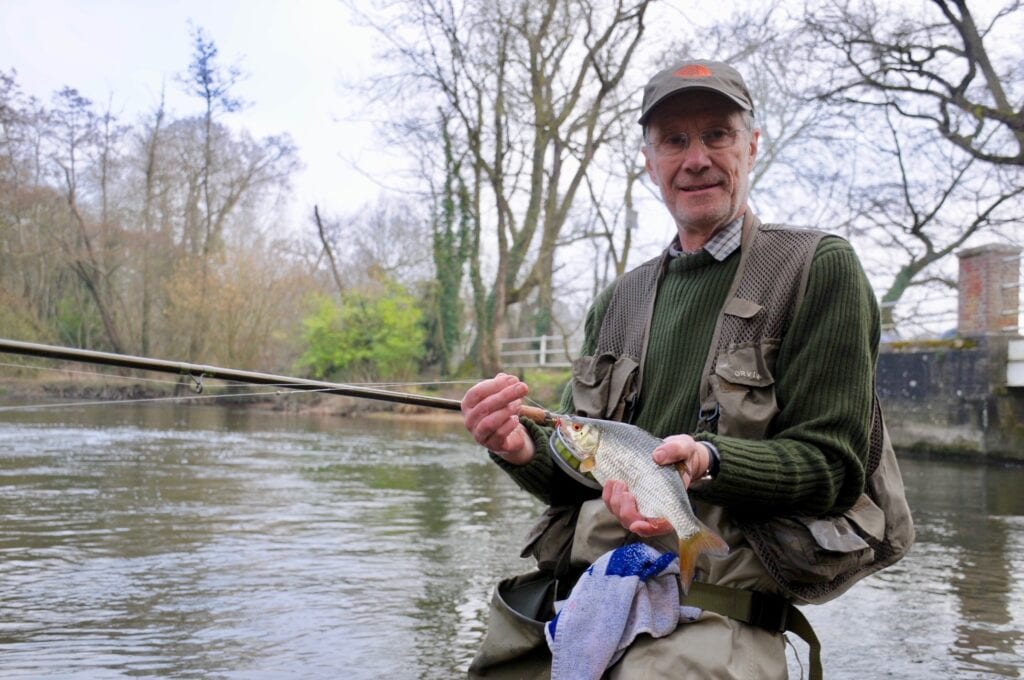

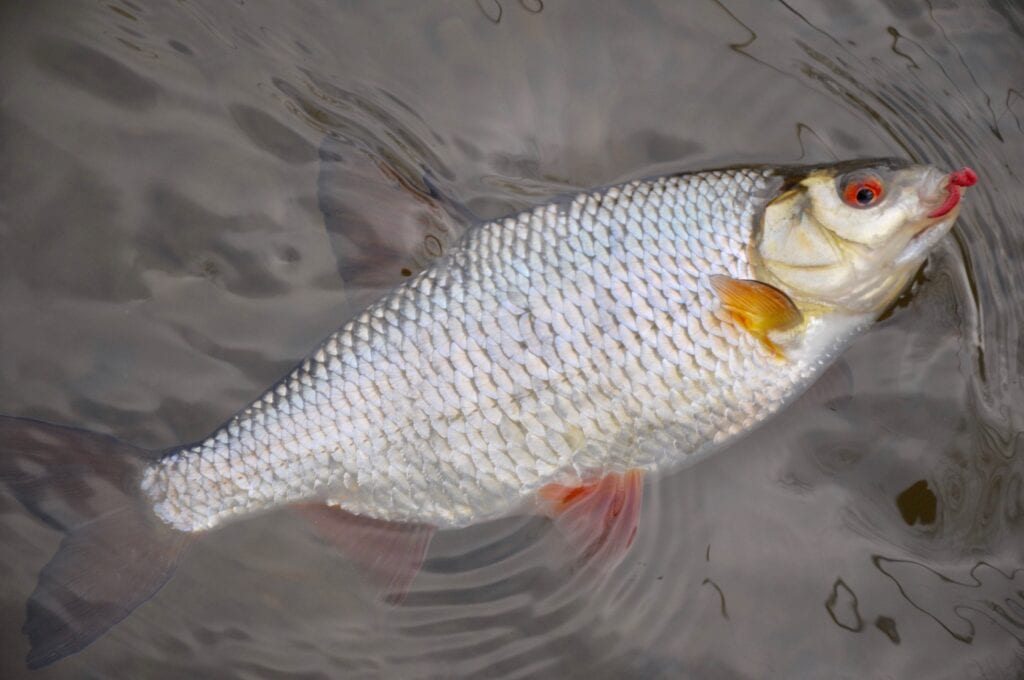

I think it was Dave Plummer who first alerted me to the power of underwater currents in big stills, and the fact that roach tend to choose these over water that is slack. Food? Oxygen? Ease of travel? I don’t know, but locating moving water has helped me in the distant past when I was on this type of roaching. Casting around with an empty feeder will help you locate the currents quite quickly once you have had experience. Anything that cuts down waiting time on big pits is good by me. Pike striking. Grebes working… even bloody cormorants. It’s those hours of inactivity I find soul-destroying. At least on rivers you can use a bit more watercraft, or just keep on the move.
LOCATION, LOCATION, LOCATION
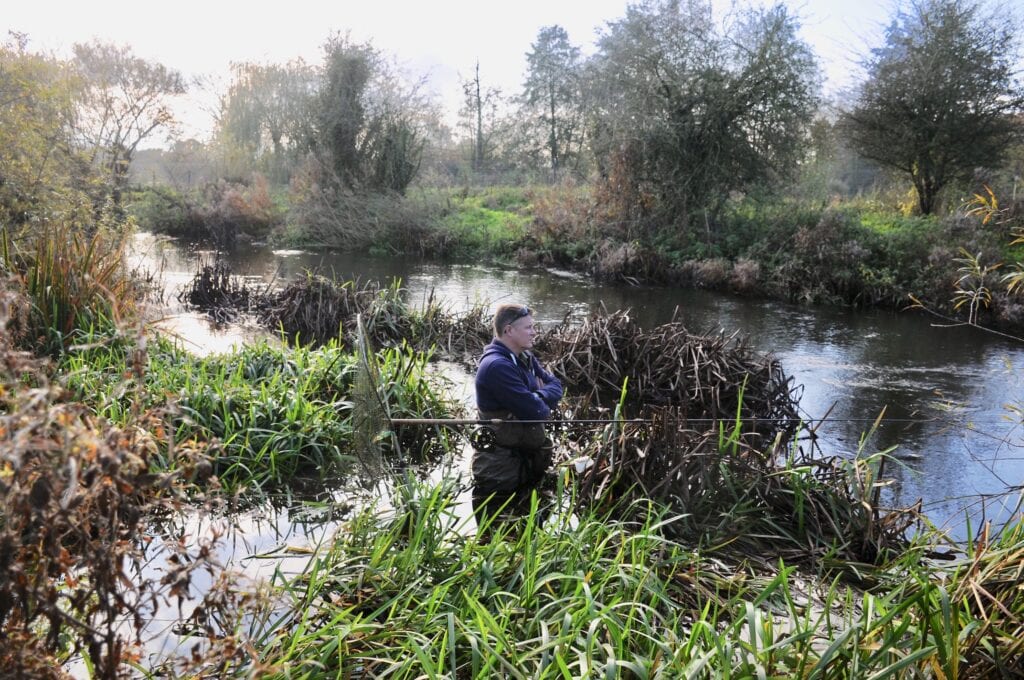

Yes, rivers are more my thing, by a long chalk… but by God they have got hard this century. (I’m straining not to mention cormorants again, and keep this about fishing!) Location is most of it, of course, as it is in every angling scenario. The internet, the grapevine, the papers, anything can give a pointer. A lot of rivers are barely fished these days, so I have a hunch there are more better roach about than we might know, BUT lonely stretches of river see maximum predation, so I might well be wrong. Urban areas tend to beat rural ones for this reason alone – look at the Wandle!
THE LONG SEARCH
A dry, hot summer is the best time to find fish. Robbie Northman and I spend days each summer simply driving, walking, and watching. One day alone we drove 120 miles and walked ten miles along six rivers until we found a group of perhaps thirty decent fish. In Norfolk, I’d say the Bure, the Wensum, the Yare, the Waveney, the Lark, the Thet, the Wissey, the Ant, for starters, all have some roach of desirable size in them. That’s a lot of water to explore. Find fish though, and the slog becomes worthwhile… even though they can move miles before the winter arrives. If you find roach in clear, shallow water you need to go very light. One day three years ago on the Bure I caught one roach on a 2BB stick float, though there were lots of fish visible. A day later, I went with a No4 pole float and had 27 over a pound. Going light was the only difference. I have been talking a lot about Tenkara on this site, and there is a lot in this. Great pal Ian Lewis is right there with me on this one. We’ll walk until we spot fish. We’ll work out their movements. Then we’ll drop a bait in a hole in the weeds, which we know they will visit on their rounds. It is pulsating stuff, and unless you are going to fish into dark, it is about the only way to catch.
AUTUMN ONWARDS
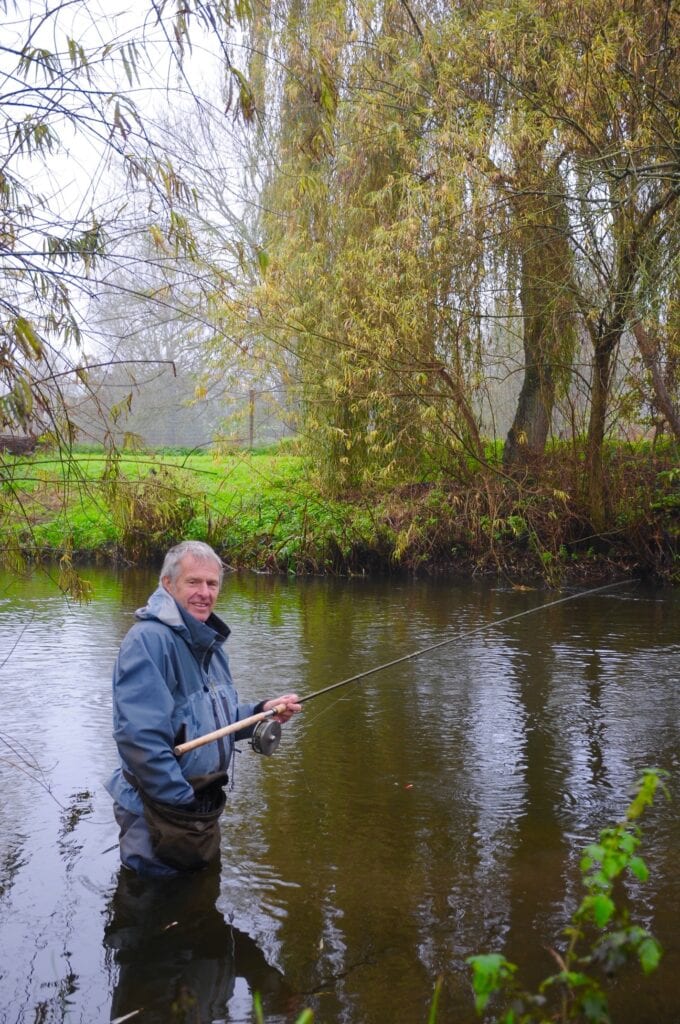

I have always thought my roaching season begins in late September and goes on to the end of the season. Dark evenings. Higher water. Coloured water. These factors hide a multitude of my sins anyway. Dawn and dusk. 12 inches visibility. 8-10 degrees air temperatures. Wind from the South and/or West. This is where roach fishing is at. Classically I go 14ft rod, pin, 3lb line, stick, size 16 and maggots, or size 12 and flake. Sadly, most of my fish have come historically at night on flake, using a tip or butt indicator. I’m not really going into details on either approach, as the phrase “sucking eggs” springs to mind, but there are dilemmas still. For example, if trotting is your game, do you roam ’till you find fish, or do you stick and build a swim up? What colour maggots? Are casters really worth the effort?.. I’ve seen hundreds of twos on maggots alone? How do you explain success on a freezing, bright day when there is gin-clear visibility, and the wind is from the East? It doesn’t happen often, but I’ve known it on occasion.
SETTING AN AMBUSH
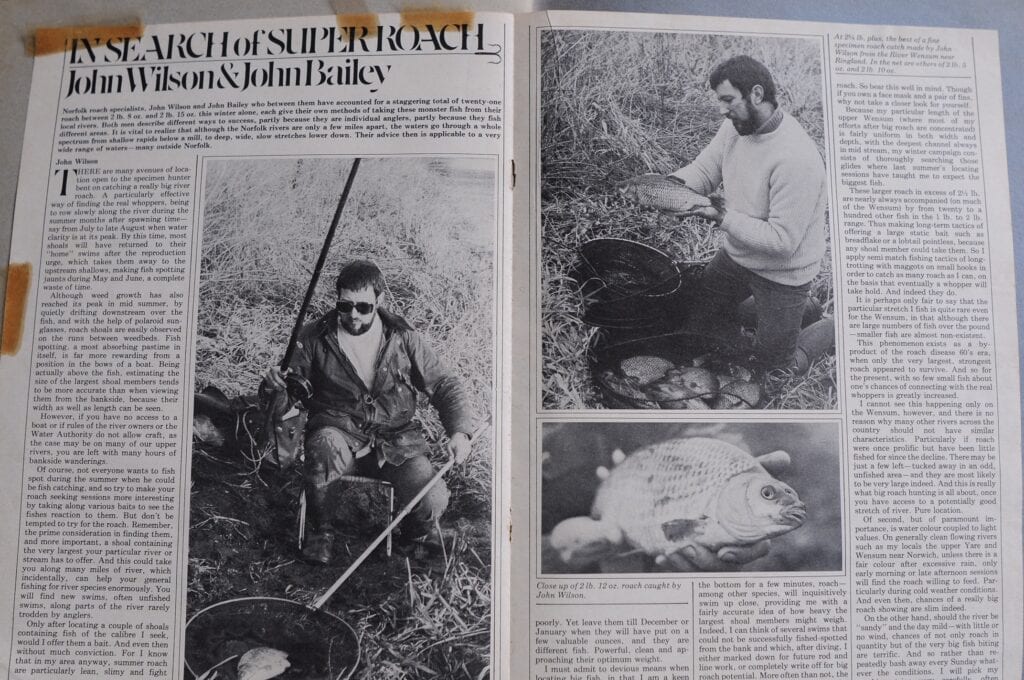

I have no doubt – yet again, those who know me will say – that prebaiting and ambushing roach is enormously effective if you have easy access to a relatively quiet river. Roger Miller and I used to put mash into clear swims five foot deep in the September evenings. We’d go back next morning to see which swims had had the mash taken. Soon a pattern built up. We’d bait up those swims over a week, and then fish into the dark, and that is how I caught my last run of “threes” back in the late 80s. A friend Joe had a stretch of river running through the wood where he had a studio. Each day he baited a bend with Vitalin, two buckets of the stuff. He didn’t fish, and just liked to put a GoPro in, but within six months, I swear he had every roach in the four-mile beat feeding in his slack. That’s extreme, but just putting in a bucket of mash, riddled with hemp, at dusk can pull roach in for you by next morning. All this is obvious stuff, but if you are really up for big roach this type of effort can make huge differences.
THE MYSTERY DEEPENS
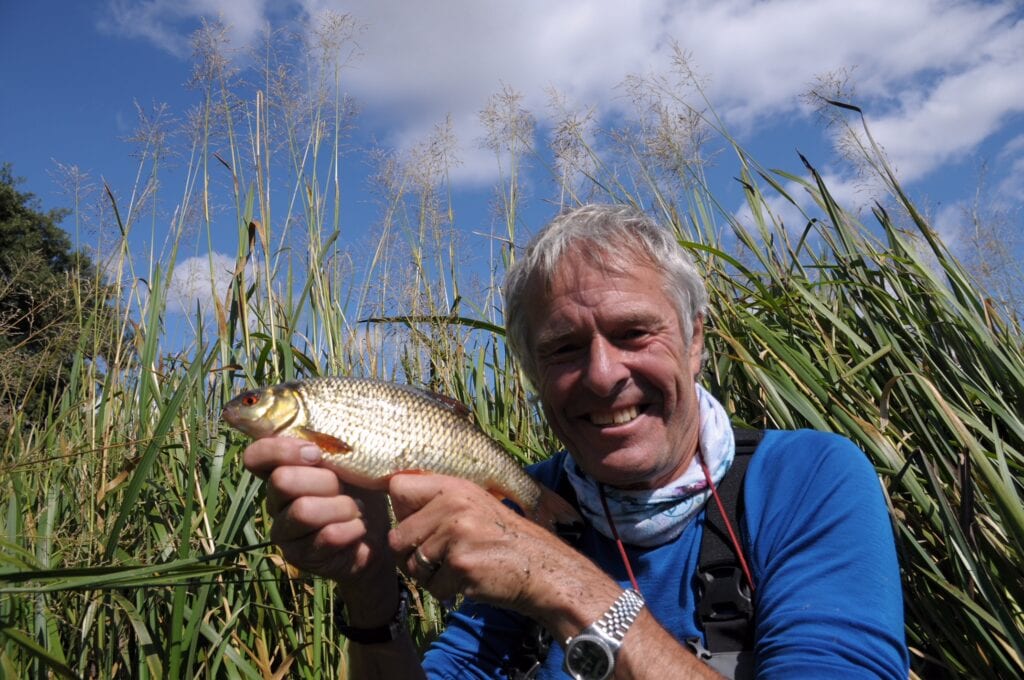

To plagiarise, whoever is tired of roach is tired of life. Those of us coming from a certain generation probably began with them and, wonderfully, their mystery and allure simply grows over the years. I love the differences between DC and myself. I wonder if he remembers a day on Kingfisher around a dozen years ago? He fished by the Island bridge, and sat on his box all day. He fed and he worked, and he began to catch fish up to around ten ounces or so. He had a real netful. Above all, he saw one or two clonkers roll in the swim, so could have had a real biggie. I watched him ’till I got restless and wandered off to the river, where I fished some ten swims over the course of a mile. I had a three pound chub and a roach of 1.01. Two different results. Two different men. Two very different approaches. I like to think this is the truth behind this series, and the fascination of fishing itself!










